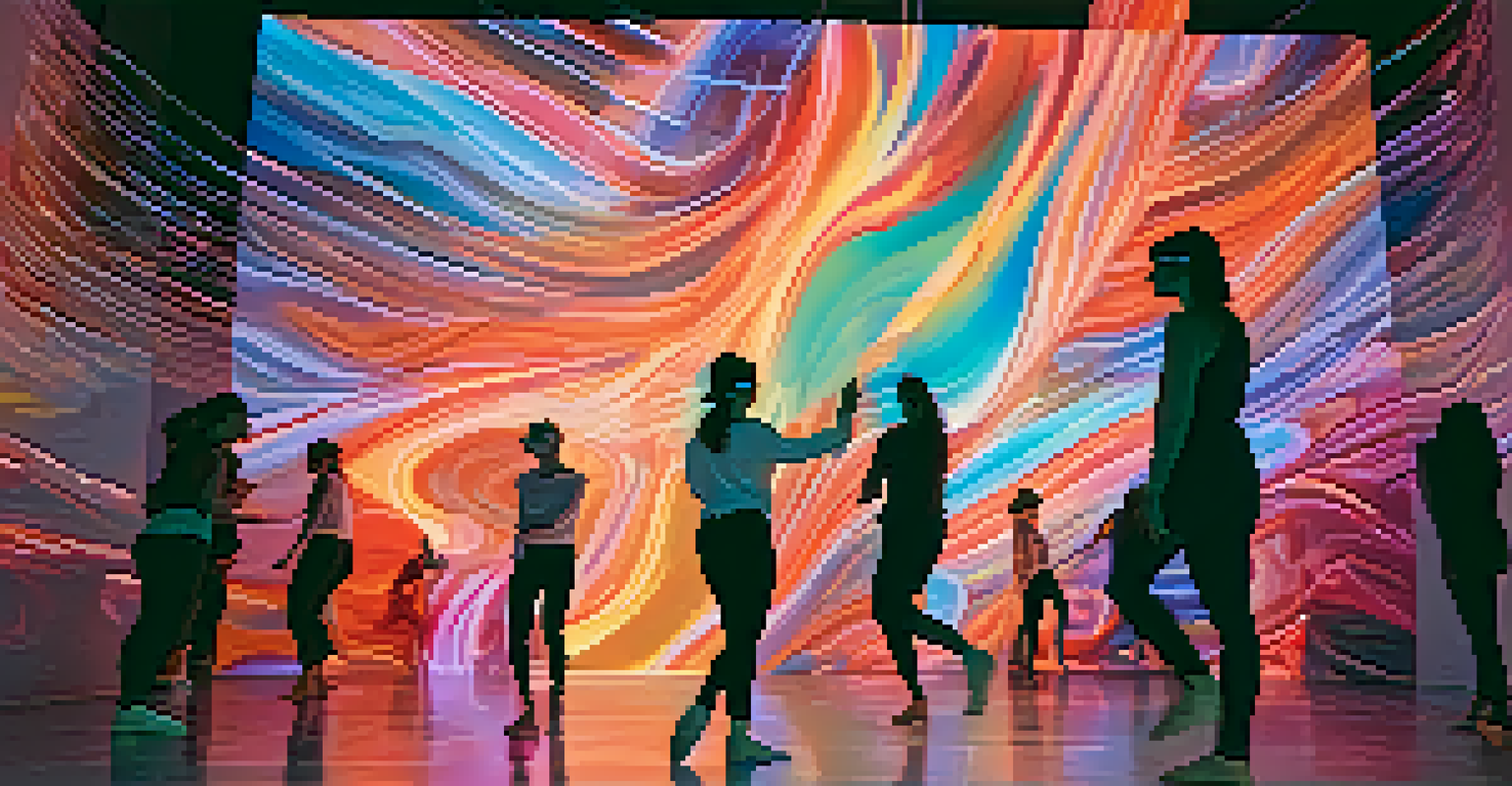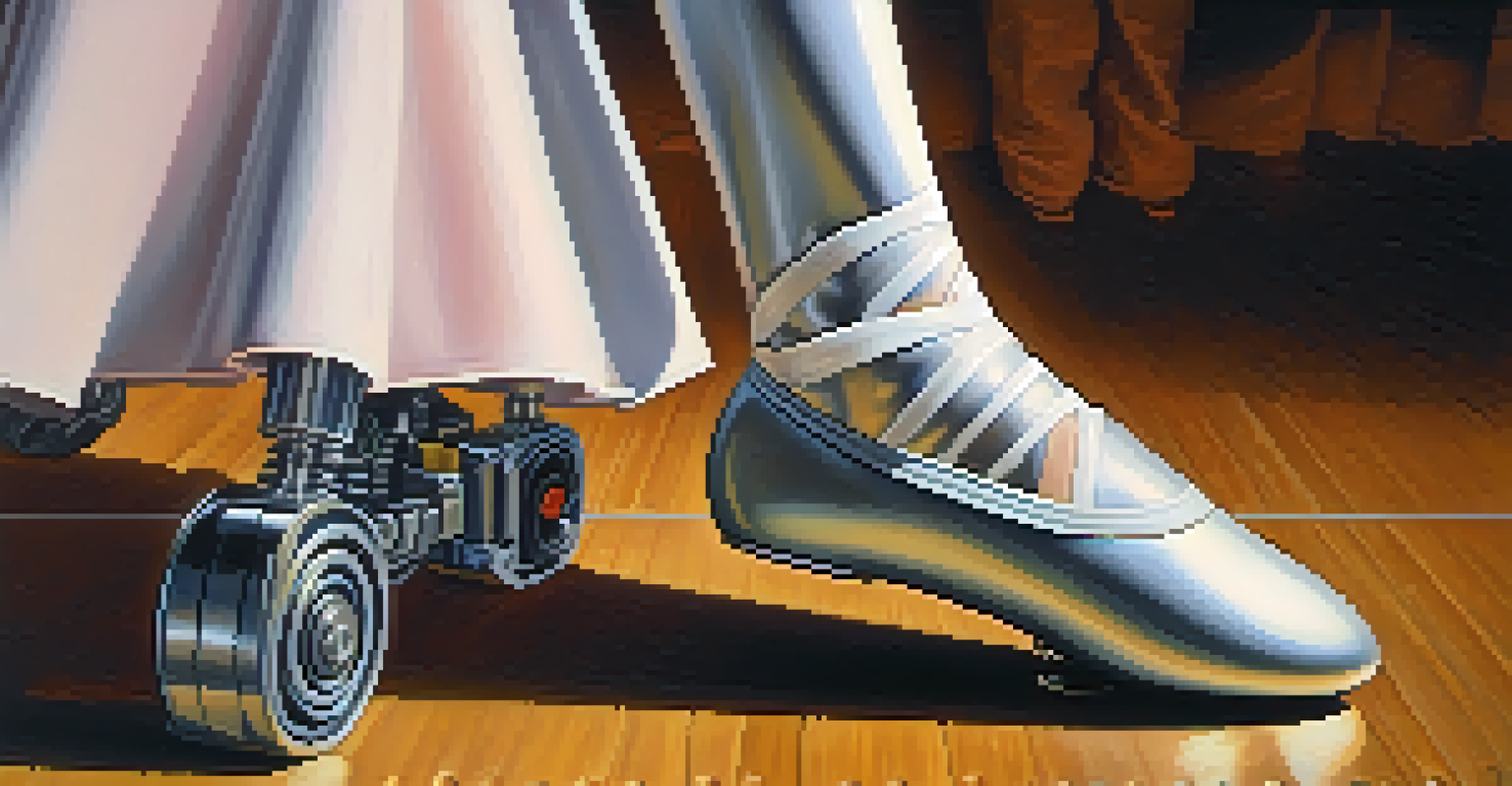Interdisciplinary Dance: Blending Movement with Robotics

Understanding Interdisciplinary Dance and Robotics
Interdisciplinary dance is an innovative approach that combines traditional dance forms with elements from other disciplines, such as technology, visual arts, and, notably, robotics. This fusion creates a rich tapestry of expression where movement becomes more than just physical; it becomes a dialogue between human creativity and technological advancement. By incorporating robotics, dancers and choreographers can explore new realms of movement that were previously unimaginable.
Dance is the hidden language of the soul.
Robotics in dance isn't just about automating movements; it’s about enhancing the storytelling aspect of performance. For instance, a robotic arm could be programmed to mimic the dancer's movements, creating a visual representation of the connection between human and machine. This interplay invites audiences to ponder questions about identity, technology, and the nature of existence itself.
As we delve deeper into this intersection, it's essential to recognize the collaborative spirit that defines interdisciplinary dance. Artists, engineers, and technologists work hand in hand to push boundaries, leading to performances that captivate and challenge audiences. This partnership not only enriches the dance experience but also opens doors to new artistic possibilities.
The Role of Technology in Dance Performance
Technology has always influenced the arts, but its integration into dance takes on a unique form with robotics. For example, motion capture technology allows dancers to translate their movements into digital data, which can then be manipulated to create stunning visual effects. This relationship between the dancer's body and digital representation enhances the overall aesthetic and emotional impact of performances.

Moreover, robotic systems can respond to a dancer's movements in real time, creating an interactive experience that blurs the line between performer and technology. Imagine a dancer performing on stage while a robot dynamically adjusts its own movements in response. This synchronicity not only showcases the potential of robotics but also creates a compelling narrative that evolves throughout the performance.
Robotics Enhances Dance Storytelling
Integrating robotics into dance elevates the storytelling aspect, allowing for dynamic interactions that provoke thought about technology and identity.
The use of technology also allows for experimentation with new formats and environments. Dancers can perform in virtual reality spaces or alongside projections that react to their movements, offering audiences a multi-sensory experience that traditional performances may lack. This innovation encourages a rethinking of how we perceive dance as an art form.
Case Studies: Notable Interdisciplinary Dance Projects
Several groundbreaking projects have emerged that showcase the potential of interdisciplinary dance and robotics. One notable example is 'Bot and Dolly's' performance 'Box', which features a dancer interacting with robotic elements and projected visuals. This project emphasizes the harmony created when technology and human expression coexist, captivating audiences worldwide.
Technology is best when it brings people together.
Another inspiring case is the collaboration between choreographer Wayne McGregor and the tech company Google. Their project, 'Living Archive', utilized machine learning to analyze McGregor's choreography and generate new movement patterns, thus creating a unique dialogue between the artist and artificial intelligence. Such initiatives highlight how interdisciplinary dance can lead to innovative artistic expressions.
These projects not only serve as entertainment but also provoke thought about the future of performance art. They challenge us to consider how technology can enhance our understanding of movement and emotion, while also inviting us to reflect on our relationship with machines in everyday life.
Challenges of Integrating Robotics into Dance
While the integration of robotics into dance presents exciting opportunities, it also comes with its fair share of challenges. One significant hurdle is the need for technical proficiency among dancers, who must often learn to work with complex machinery and software. This learning curve can be daunting, especially for those who have spent years honing their traditional dance skills.
Moreover, the unpredictable nature of live performances can lead to technical difficulties. For instance, if a robotic component fails mid-performance, it could disrupt the entire flow of the piece. Dancers must be prepared to adapt and improvise, highlighting the importance of resilience in this evolving art form.
Challenges in Dance and Tech Fusion
While the collaboration between dance and robotics opens new artistic avenues, it also presents challenges such as technical proficiency and maintaining human expression.
Lastly, there are artistic concerns regarding the balance between human expression and robotic precision. Dancers and choreographers must navigate the fine line between using technology as a tool for enhancement and allowing it to overshadow the human element of performance. Striking this balance is crucial for maintaining the integrity of the art form.
The Future of Dance in the Age of Robotics
As technology continues to evolve, the future of dance promises to be both exciting and transformative. We are likely to see even more innovative projects that incorporate cutting-edge robotics, offering new ways for artists to express themselves and engage with audiences. This evolution will allow for increasingly complex choreography and narratives that push the boundaries of traditional dance.
Additionally, as artificial intelligence (AI) becomes more sophisticated, we may witness collaborations between humans and machines that lead to entirely new genres of dance. Imagine a performance where AI-generated choreography adapts in real time to audience reactions, creating a unique experience for each viewer. This potential for personalization could revolutionize how we experience performance art.
Ultimately, the intersection of dance and robotics holds the promise of broadening the scope of artistic expression. By embracing technology, dancers can explore uncharted territories, challenge societal norms, and foster deeper connections with their audiences. The future of interdisciplinary dance is bright, and we are just beginning to scratch the surface of what’s possible.
Engaging Audiences Through Interdisciplinary Dance
One of the most compelling aspects of interdisciplinary dance is its ability to engage audiences on multiple levels. By blending movement with robotics, performances can evoke emotions, provoke thought, and inspire dialogue. This multi-faceted approach invites viewers to not just observe but to actively participate in the experience, fostering a deeper connection to the art.
For instance, interactive installations that allow audience members to influence the performance through their movements create an immersive environment where everyone plays a role. This engagement transforms the traditional passive viewing experience into an active collaboration, breaking down barriers between performer and audience.
Future of Dance is Technology-Driven
The future of dance is set to be transformed by technology, with potential for AI-driven choreography and personalized audience experiences.
Additionally, the use of social media and digital platforms amplifies the reach of these performances, allowing for a global audience to engage with the work. Viewers can share their thoughts and experiences online, creating a community of dialogue that extends beyond the physical performance. This interconnectedness enriches the overall experience and highlights the universal nature of dance.
Conclusion: The Impact of Interdisciplinary Dance
In conclusion, the blending of movement with robotics in interdisciplinary dance is shaping a new era of artistic expression. This innovative approach not only expands the possibilities of choreography but also invites audiences to engage in meaningful conversations about technology, identity, and the human experience. As artists continue to explore this intersection, we can anticipate a future filled with creativity and collaboration.
By embracing the challenges and opportunities that come with integrating robotics into dance, performers can push the boundaries of their art. This evolution encourages experimentation and fosters an environment where new ideas can flourish, paving the way for the next generation of artists.

Ultimately, interdisciplinary dance serves as a powerful reminder of the potential for collaboration between humanity and technology. As we move forward, we must remain open to the possibilities that lie ahead, ensuring that this dynamic relationship continues to inspire and captivate audiences for years to come.